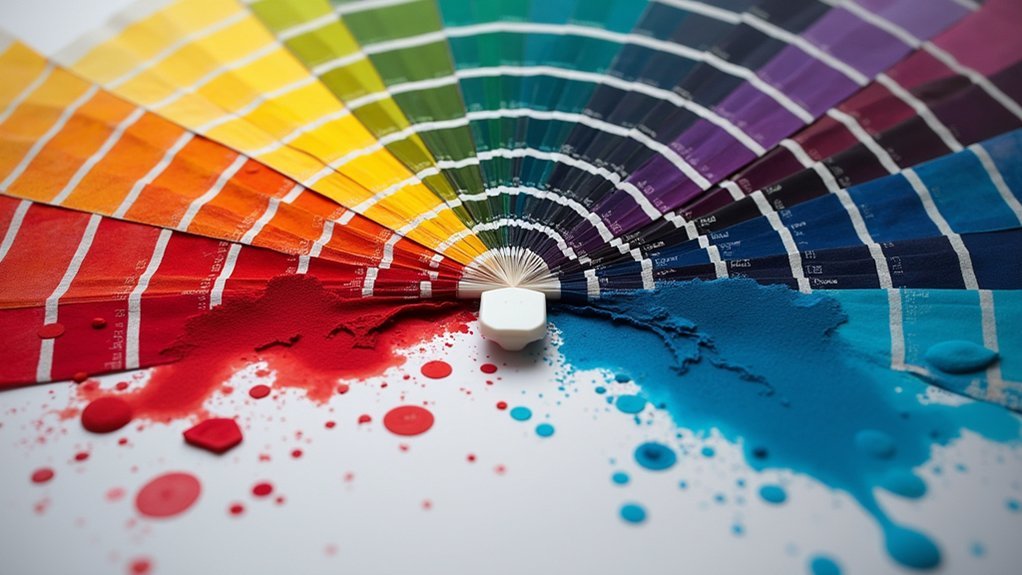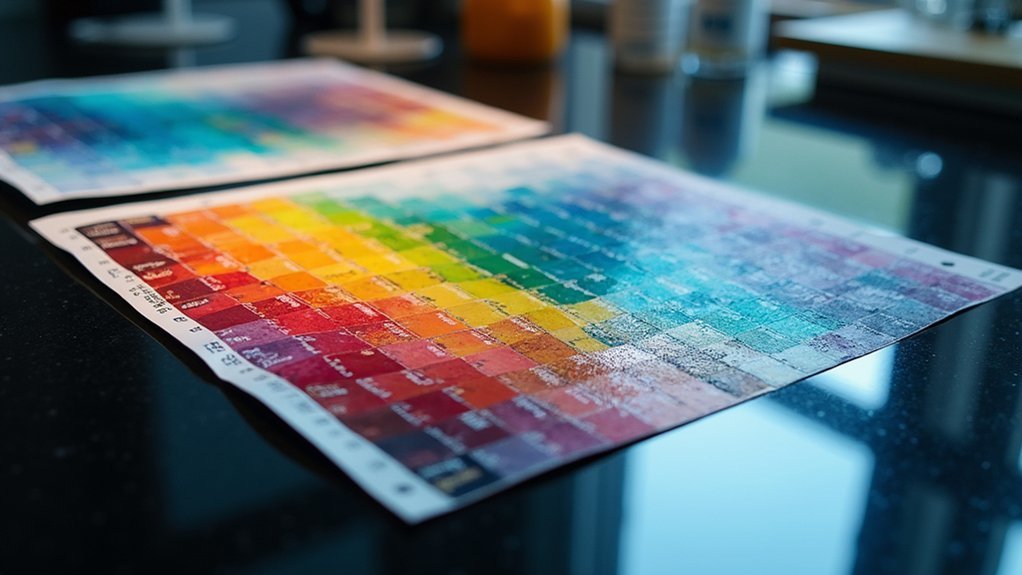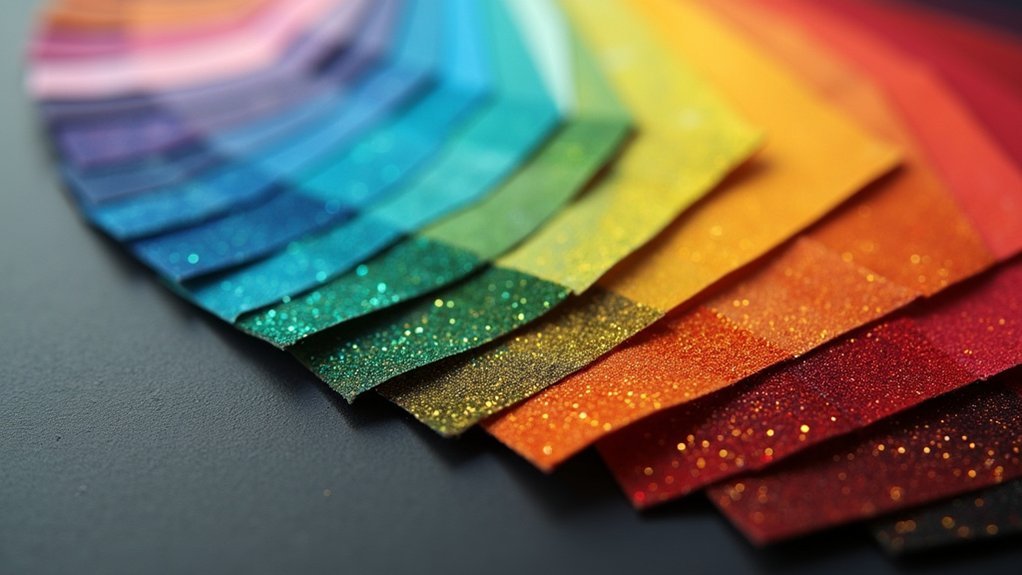The best color standards for digital imaging depend on your application. For web content, sRGB is universal, while Adobe RGB offers a wider gamut for professional photography and scientific work. DCI-P3 provides superior accuracy for high-end displays, BT-709 serves broadcast needs, and DICOM guarantees precision in medical imaging. Your choice should align with your specific needs, from microscopy to pathology. Understanding these standards will transform how accurately you capture and display your digital images.
NUMERIC LIST OF 5 SECOND-LEVEL HEADING(S) IN ENGLISH

Several key color standards dominate the digital imaging landscape, each serving specific purposes across different media.
When working with digital images, you’ll need to choose the right color space for your project:
- sRGB: The Universal Standard for Web and Social Media
- Adobe RGB: Expanding Your Color Gamut for Professional Photography
- DCI-P3: Superior Color Accuracy for Cinema and Display Technology
- BT-709: The Broadcast Standard for High-Definition Content
- CMYK: Essential Color Management for Print Production
Each standard requires proper ICC profile handling to maintain color accuracy across devices.
Your file format choice also affects how color information is preserved, so select your color space based on your output medium—whether it’s digital displays or physical prints.
Microscope Color Calibration Fundamentals: From RGB to Advanced Gamuts
While selecting the right color standard forms the foundation of digital imaging, microscopy presents unique calibration challenges that require specialized approaches. You’ll need to understand the RGB color model as your starting point, then progress to advanced gamuts like Adobe RGB or DCI-P3 for enhanced biological sample representation.
Regular calibration using tools like the X-Rite Digital ColorChecker guarantees your captured images maintain color accuracy across different devices. Don’t forget to embed ICC profiles in your microscope images to preserve color consistency.
| Gamut Type | Color Space | Applications |
|---|---|---|
| Standard | sRGB | Basic imaging |
| Advanced | Adobe RGB | Enhanced visible color |
| Professional | DCI-P3 | Research-grade imaging |
| Scientific | ProPhoto RGB | Maximum color accuracy |
Comparing Color Standards for Scientific Microscopy Applications

Although numerous color standards exist in the digital world, scientific microscopy requires specialized attention to color fidelity for accurate specimen representation.
When you’re selecting a color standard, consider that Adobe RGB offers a wider gamut than standard RGB color space, revealing subtle variations in biological specimens that might otherwise be lost.
ICC profiles are essential for consistent color reproduction across different microscopy applications, ensuring that what you see matches reality.
You’ll find DICOM standards particularly valuable when your microscopy serves diagnostic purposes, as they maintain color accuracy throughout the imaging chain.
Before finalizing your digital images, implement soft proofing techniques to verify how colors will appear across different output media. This approach guarantees that the critical visual data you’ve captured remains intact regardless of viewing platform.
Color Fidelity in Digital Pathology: Standards and Best Practices
Because accurate diagnosis depends on precise color representation, digital pathology demands exceptional color fidelity standards. You’ll need to adhere to DICOM standards for medical imaging displays to guarantee diagnostic accuracy.
Implementing robust color management starts with calibrated monitors that support DICOM profiles, maintaining critical tissue distinction capabilities.
Precise color calibration through DICOM-compliant displays forms the backbone of reliable tissue differentiation in diagnostic pathology.
For maximum results, embed ICC profiles within your images to preserve color integrity across different viewing platforms. Consider utilizing wide-gamut color spaces like Adobe RGB or DCI-P3, which display a broader color spectrum and enhance your diagnostic capabilities.
Regular calibration of display devices is essential—not just during initial setup but as an ongoing practice. This systematic approach to color accuracy in digital pathology workflows guarantees reliable interpretation of histopathological images, ultimately supporting better patient outcomes.
Calibration Targets and Reference Charts for Microscope Imaging

Precision in microscope imaging begins with proper calibration targets and reference charts. When you’re working with multiple imaging devices, tools like the X-Rite ColorChecker guarantee accurate color reproduction across your workflow.
By incorporating reference charts that comply with ISO 3664 standards, you’ll establish consistent viewing conditions that enhance color assessment reliability.
- Regular calibration counteracts color deviations caused by lighting variations, microscope settings, and camera sensor differences.
- Embedding calibration data into your imaging process maintains color profiles, supporting trustworthy scientific observations.
- Using targets with standardized color patches and gray scales allows for precise adjustments and consistent color fidelity.
Don’t underestimate the importance of these tools—they’re essential for maintaining reproducibility and standardization in your microscope imaging work.
Frequently Asked Questions
Which Color Mode Should You Use for Digital Images?
For digital images, you should use sRGB color mode for web and general digital use. If you’re doing professional print work, Adobe RGB might be better, but you’ll need a color-managed workflow.
What Are the Digital Color Standards?
Digital color standards include sRGB (most common for web/displays), Adobe RGB (professional photography), DCI-P3 (cinema/high-end displays), BT-709 (HD broadcasting), and DICOM (medical imaging). You’ll typically use sRGB for everyday digital content.
What Color Profile Is the Most Accurate?
Adobe RGB (1998) is generally the most accurate color profile for detailed work. It offers a wider gamut than sRGB, but you’ll find sRGB more practical for web content due to its universal compatibility.
What Is the Standard for Color Accuracy?
The standard for color accuracy is sRGB for digital imaging and web content. You’ll find it’s universally supported across devices, while ICC profiles guarantee consistency when you’re working across different platforms and applications.
In Summary
You’ve now explored essential color standards that guarantee accuracy in your digital microscopy work. By implementing proper RGB profiles, calibration targets, and industry standards, you’ll achieve consistent results across different systems. Remember, your choice of color gamut directly impacts diagnostic reliability in pathology. Don’t overlook regular calibration—it’s the foundation of reliable scientific imaging. Apply these standards to maintain color fidelity in all your digital imaging applications.





Leave a Reply